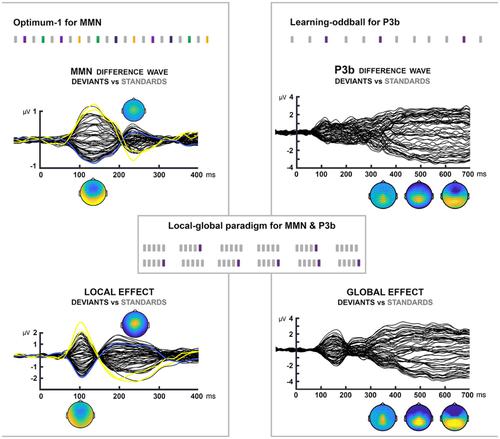当前位置:
X-MOL 学术
›
Eur. J. Nerosci.
›
论文详情
Our official English website, www.x-mol.net, welcomes your feedback! (Note: you will need to create a separate account there.)
Assessing mismatch negativity (MMN) and P3b within-individual sensitivity — A comparison between the local–global paradigm and two specialized oddball sequences
European Journal of Neroscience ( IF 3.4 ) Pub Date : 2024-03-04 , DOI: 10.1111/ejn.16302 Renate Rutiku 1, 2 , Chiara Fiscone 1 , Marcello Massimini 1, 3 , Simone Sarasso 1
European Journal of Neroscience ( IF 3.4 ) Pub Date : 2024-03-04 , DOI: 10.1111/ejn.16302 Renate Rutiku 1, 2 , Chiara Fiscone 1 , Marcello Massimini 1, 3 , Simone Sarasso 1
Affiliation

|
Mismatch negativity (MMN) and P3b are well known for their clinical utility. There exists no gold standard, however, for acquiring them as EEG markers of consciousness in clinical settings. This may explain why the within-individual sensitivity of MMN/P3b paradigms is often quite poor and why seemingly identical EEG markers can behave differently across Disorders of consciousness (DoC) studies. Here, we compare two traditional paradigms for MMN or P3b assessment with the recently more popular local–global paradigm that promises to assess MMN and P3b orthogonally within one oddball sequence. All three paradigms were administered to healthy participants (N = 15) with concurrent EEG. A clear MMN and local effect were found for 15/15 participants. The P3b and global effect were found for 14/15 and 13/15 participants, respectively. There were no systematic differences between the global effect and P3b. Indeed, P3b amplitude was highly correlated across paradigms. The local effect differed clearly from the MMN, however. It occurred earlier than MMN and was followed by a much more prominent P3a. The peak latencies and amplitudes were also not correlated across paradigms. Caution should therefore be exercised when comparing the local effect and MMN across studies. We conclude that the within-individual MMN sensitivity is adequate for both the local–global and a dedicated MMN paradigm. The within-individual sensitivity of P3b was lower than expected for both the local–global and a dedicated P3b paradigm, which may explain the often-low sensitivity of P3b paradigms in patients with DoC.
中文翻译:

评估错配负性 (MMN) 和 P3b 个体敏感性 — 局部-全局范式与两个专门的奇怪序列之间的比较
错配阴性 (MMN) 和 P3b 因其临床实用性而闻名。然而,在临床环境中获取它们作为意识的脑电图标记并不存在黄金标准。这可以解释为什么 MMN/P3b 范式的个体敏感性通常很差,以及为什么看似相同的脑电图标记在意识障碍 (DoC) 研究中可能表现不同。在这里,我们将 MMN 或 P3b 评估的两种传统范式与最近更流行的局部-全局范式进行比较,该范式承诺在一个奇怪的序列内正交评估 MMN 和 P3b。所有三种范例均对健康参与者(N = 15)进行,并同时进行脑电图检查。15/15 的参与者发现了明显的 MMN 和局部效应。分别为 14/15 和 13/15 的参与者发现了 P3b 和全局效应。整体效应与 P3b 之间不存在系统性差异。事实上,P3b 幅度在不同范式之间高度相关。然而,局部效果与 MMN 明显不同。它发生得早于 MMN,随后出现了更为突出的 P3a。峰值延迟和振幅在不同范式之间也不相关。因此,在比较不同研究的局部效应和 MMN 时应谨慎。我们的结论是,个体内部 MMN 敏感性对于局部-全局和专用 MMN 范式来说是足够的。对于局部-全局和专用 P3b 范式,P3b 的个体内敏感性均低于预期,这可能解释了 DoC 患者中 P3b 范式的敏感性通常较低。
更新日期:2024-03-04
中文翻译:

评估错配负性 (MMN) 和 P3b 个体敏感性 — 局部-全局范式与两个专门的奇怪序列之间的比较
错配阴性 (MMN) 和 P3b 因其临床实用性而闻名。然而,在临床环境中获取它们作为意识的脑电图标记并不存在黄金标准。这可以解释为什么 MMN/P3b 范式的个体敏感性通常很差,以及为什么看似相同的脑电图标记在意识障碍 (DoC) 研究中可能表现不同。在这里,我们将 MMN 或 P3b 评估的两种传统范式与最近更流行的局部-全局范式进行比较,该范式承诺在一个奇怪的序列内正交评估 MMN 和 P3b。所有三种范例均对健康参与者(N = 15)进行,并同时进行脑电图检查。15/15 的参与者发现了明显的 MMN 和局部效应。分别为 14/15 和 13/15 的参与者发现了 P3b 和全局效应。整体效应与 P3b 之间不存在系统性差异。事实上,P3b 幅度在不同范式之间高度相关。然而,局部效果与 MMN 明显不同。它发生得早于 MMN,随后出现了更为突出的 P3a。峰值延迟和振幅在不同范式之间也不相关。因此,在比较不同研究的局部效应和 MMN 时应谨慎。我们的结论是,个体内部 MMN 敏感性对于局部-全局和专用 MMN 范式来说是足够的。对于局部-全局和专用 P3b 范式,P3b 的个体内敏感性均低于预期,这可能解释了 DoC 患者中 P3b 范式的敏感性通常较低。



























 京公网安备 11010802027423号
京公网安备 11010802027423号